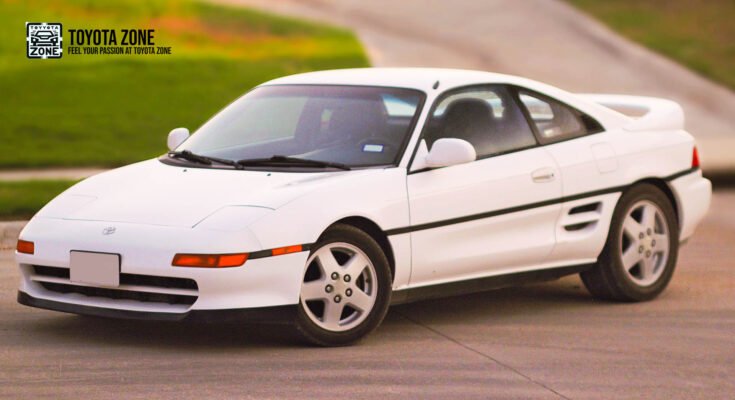The 1991 Toyota MR2 is a captivating blend of 90s sports car nostalgia and raw driving excitement. Emerging from the golden era of Japanese performance cars, this model, part of the second-generation SW20 line, brought a sense of exotic flair to the roads without the exotic price tag. With its mid-engine, rear-wheel-drive layout, sleek styling, and pop-up headlights, the 1991 Toyota MR2 offered an experience that felt more like a mini Ferrari than an everyday coupe. It wasn’t just about looks, though—this car delivered a balanced and agile ride that made every twist and turn of the road an adventure. For those seeking a sports car that combines affordability, distinct design, and engaging performance, the 1991 MR2 remains a beloved classic that captures the spirit of driving joy.
Overview of the 1991 Toyota MR2
- Body Style: Two-door, mid-engine sports coupe or T-top.
- Engine Options:
- 2.2L 5S-FE Inline-4: Naturally aspirated, producing about 130 hp.
- 2.0L 3S-GTE Turbocharged Inline-4: More powerful, with around 200 hp in the U.S. market, providing a significant boost in performance.
- Transmission: Available with a 5-speed manual transmission or 4-speed automatic.
Design and Styling
- Sleek and Aerodynamic Design: The 1991 MR2 had a modernized and more curvaceous body compared to the first-generation (AW11) MR2. Its styling resembled more expensive European sports cars of the time, earning it the nickname “Baby Ferrari.”
- Pop-up Headlights: One of the iconic design features of this era, the pop-up headlights gave the MR2 a sporty and dynamic look that remains a nostalgic feature for enthusiasts today.
- T-top Roof Option: The T-top version, which featured removable roof panels, added a semi-convertible experience, giving drivers the option to enjoy open-air motoring on sunny days.
Performance and Handling
- Mid-Engine, Rear-Wheel Drive Layout: The mid-engine placement contributed to a balanced weight distribution, making the MR2 a nimble handler. This setup is rare for cars in its price range, giving it a pure sports car feel.
- 3S-GTE Turbo Model: With its turbocharged engine, the 3S-GTE version was the performance choice, capable of achieving 0-60 mph in around 6 seconds, which was quite quick for the era.
- Precise Steering and Agile Handling: The steering feel and suspension tuning made the MR2 known for its sharp handling. Enthusiasts appreciated its cornering ability, though it earned a reputation for being tricky to handle at the limit, especially in the turbo models, due to the mid-engine layout.
Interior and Features
- Driver-Centric Cockpit: The interior design focused on the driver, with a wraparound dashboard and easy-to-reach controls. It featured sports seats that offered good support during spirited driving.
- Simple but Functional Interior: While the interior materials were fairly basic, the ergonomic design made it comfortable for daily use. The seating position was low and sporty, adding to the feeling of being in a genuine sports car.
- Limited Storage Space: Like many sports cars, the MR2’s storage space was limited, with a small front trunk (“frunk”) and additional storage behind the seats. However, this is part of the mid-engine design trade-off.
Popularity and Legacy
- Affordability with Exotic Appeal: The 1991 MR2 was celebrated for offering a mid-engine layout and sharp handling at a price significantly lower than European sports cars like Ferrari or Porsche.
- Enthusiast Favorite: It has become a beloved car among car enthusiasts, particularly those who enjoy tuning and modifications. The 3S-GTE engine is known for being mod-friendly, making it popular in the aftermarket scene.
- Collector Interest: With its iconic 90s design and engaging driving dynamics, the 1991 MR2 has become a sought-after classic sports car, especially in well-maintained or unmodified condition. It holds a special place in the hearts of those who appreciate 90s Japanese sports cars.
Challenges and Considerations
- Snap Oversteer Reputation: One of the criticisms of the 1991 MR2, especially in its turbo form, was its tendency for snap oversteer—a characteristic of mid-engine cars where the rear can lose grip suddenly in hard cornering if the driver isn’t experienced.
- Parts Availability: As with many older vehicles, some replacement parts can be harder to find, especially body panels and specific engine components. However, a strong enthusiast community helps with sourcing parts and offering advice.
- Maintenance Needs: Being a performance-oriented vehicle, it’s important to stay on top of regular maintenance to keep it running smoothly. The turbo version, in particular, can be more demanding in terms of upkeep.
Overall, the 1991 Toyota MR2 (SW20) is remembered for being a fun-to-drive, affordable sports car with exotic styling and a mid-engine layout. It remains a cult classic among driving enthusiasts who appreciate its raw driving experience and nostalgic charm.
Source : Wiki

